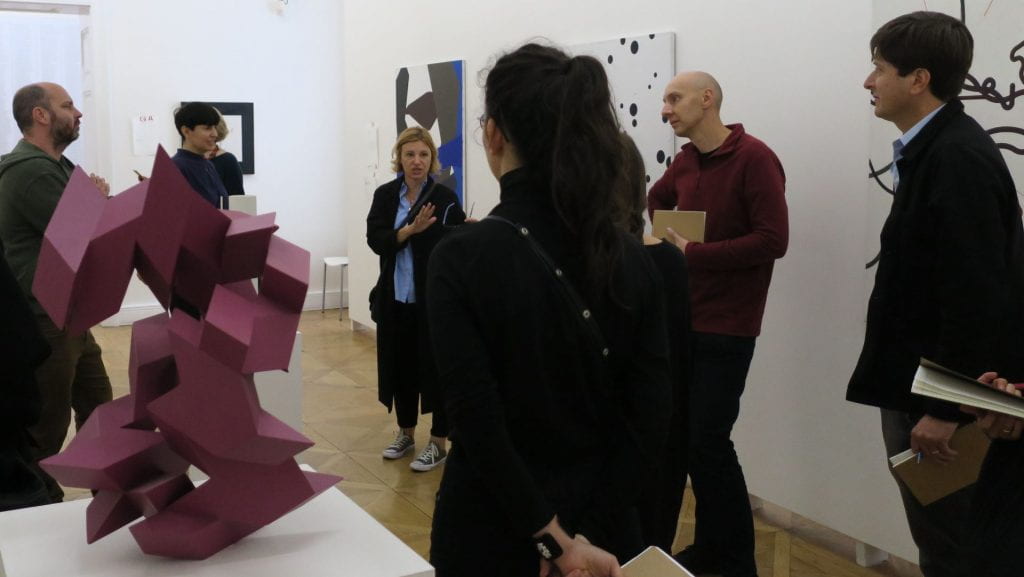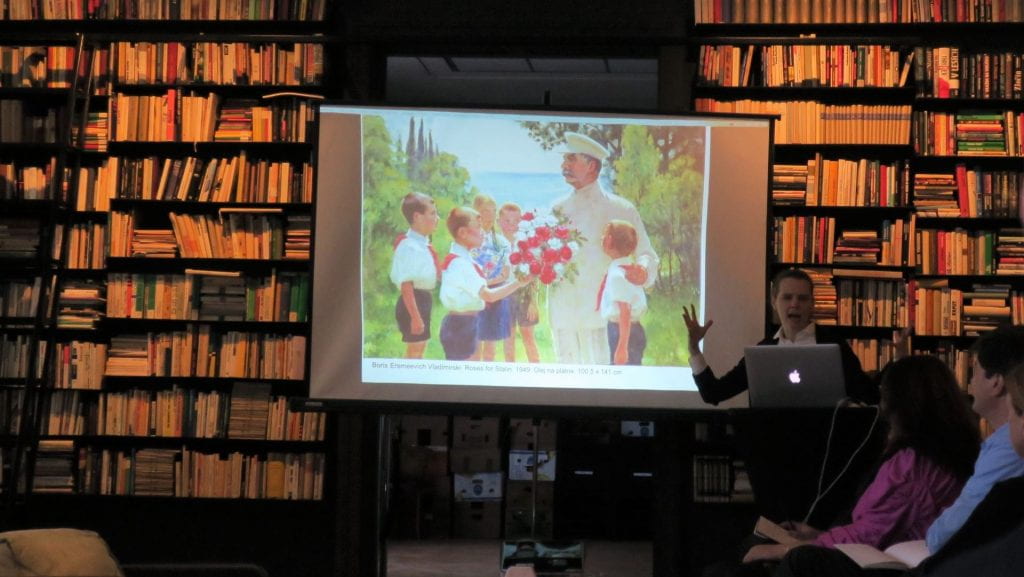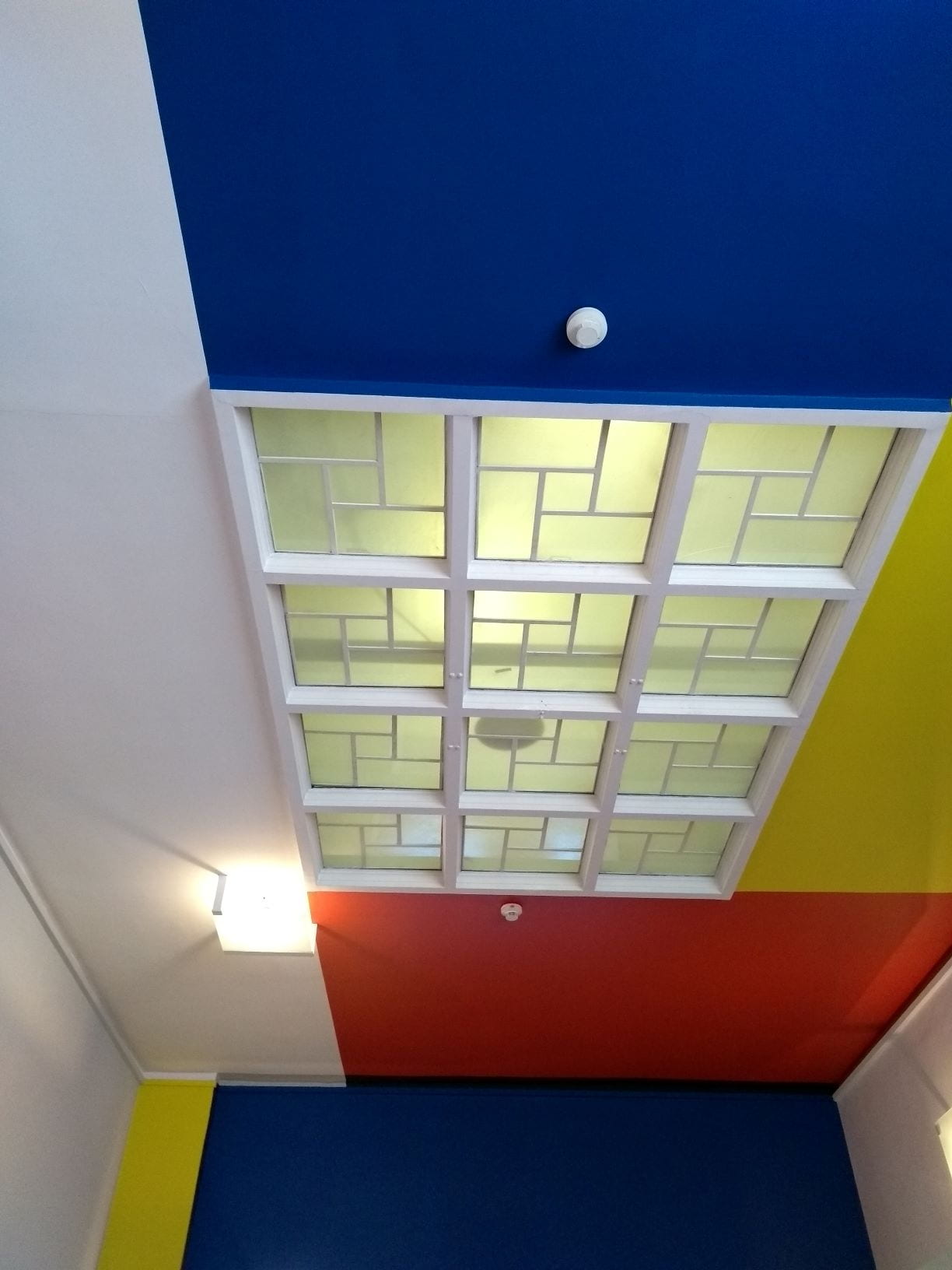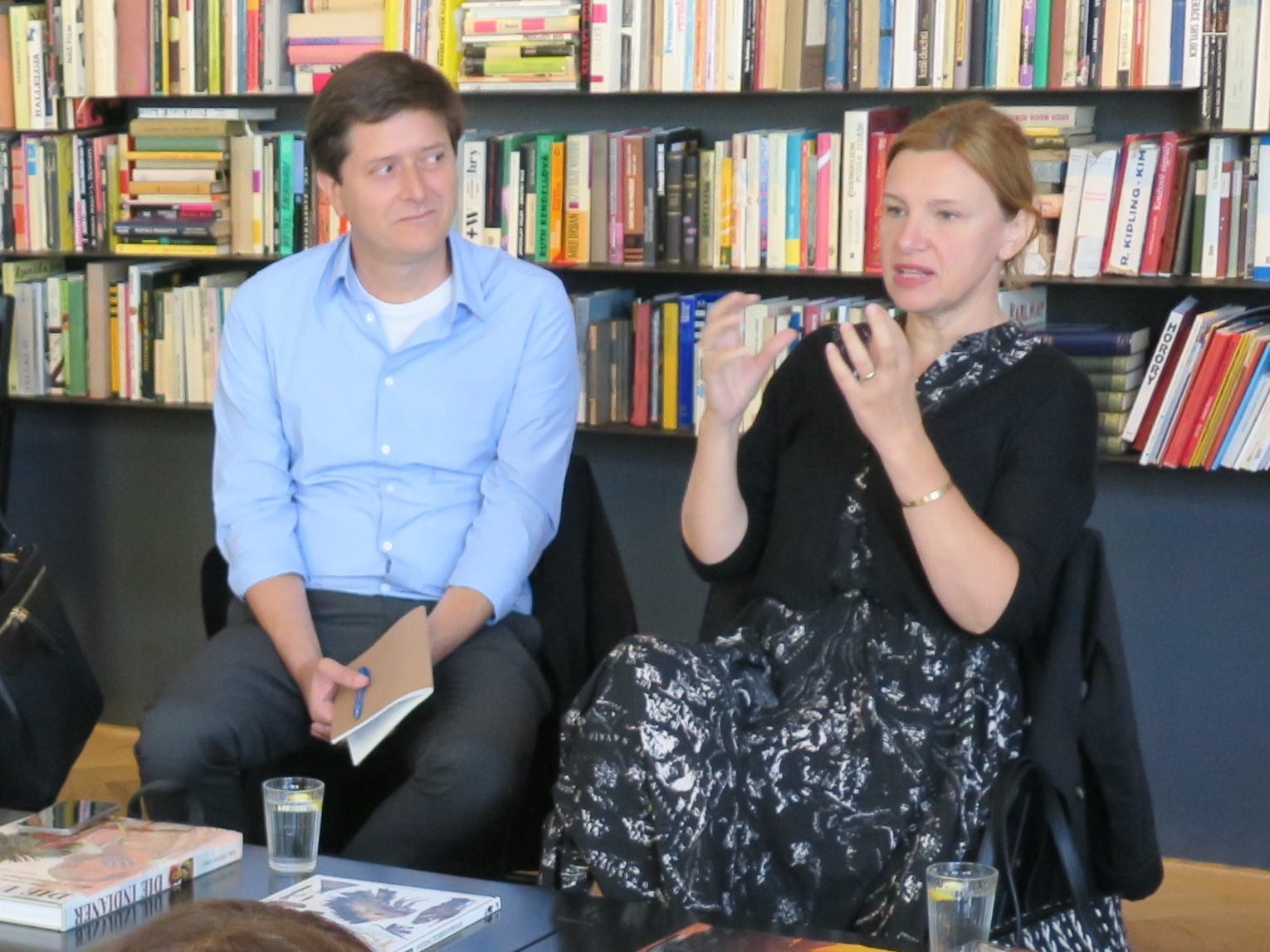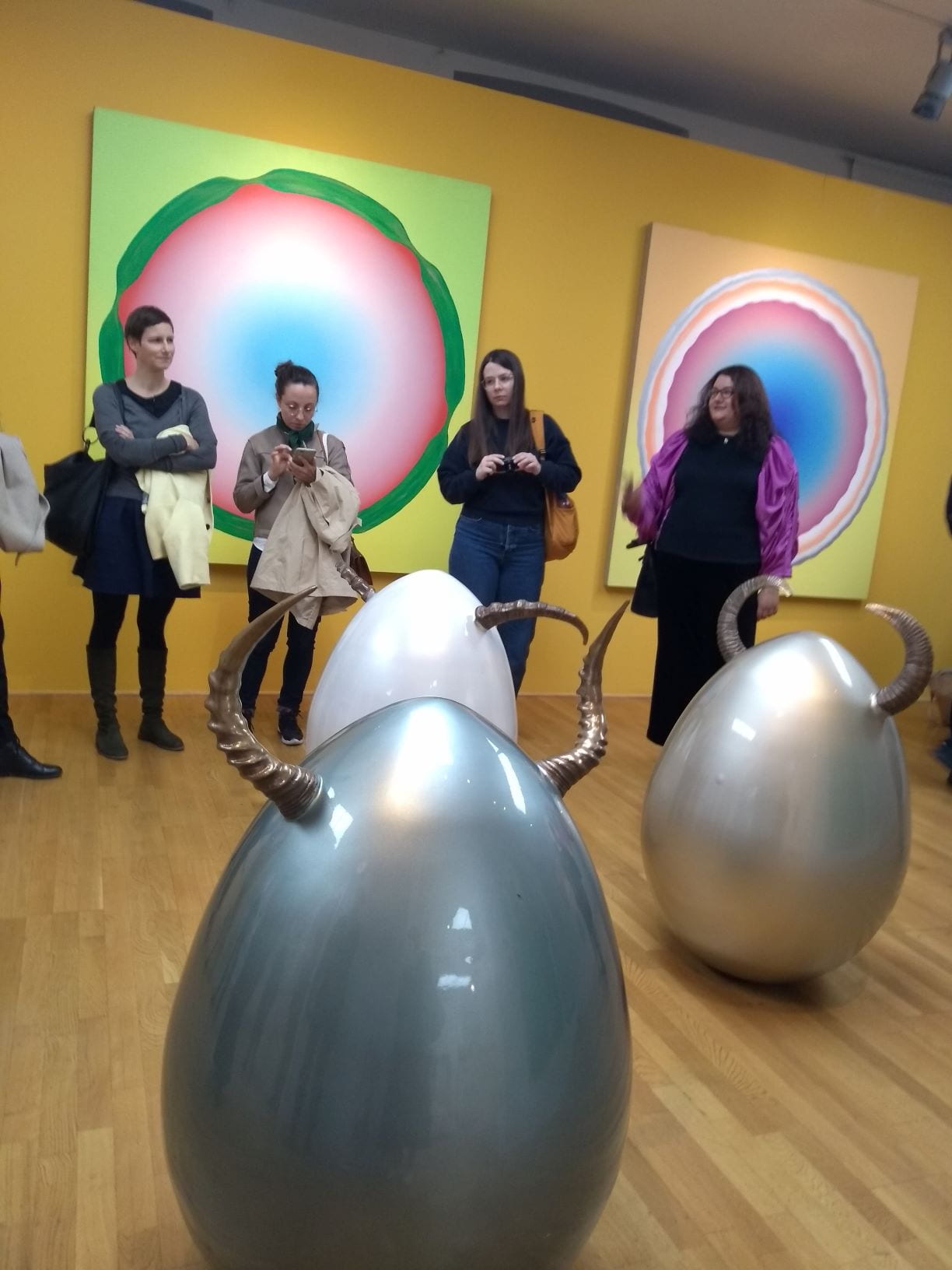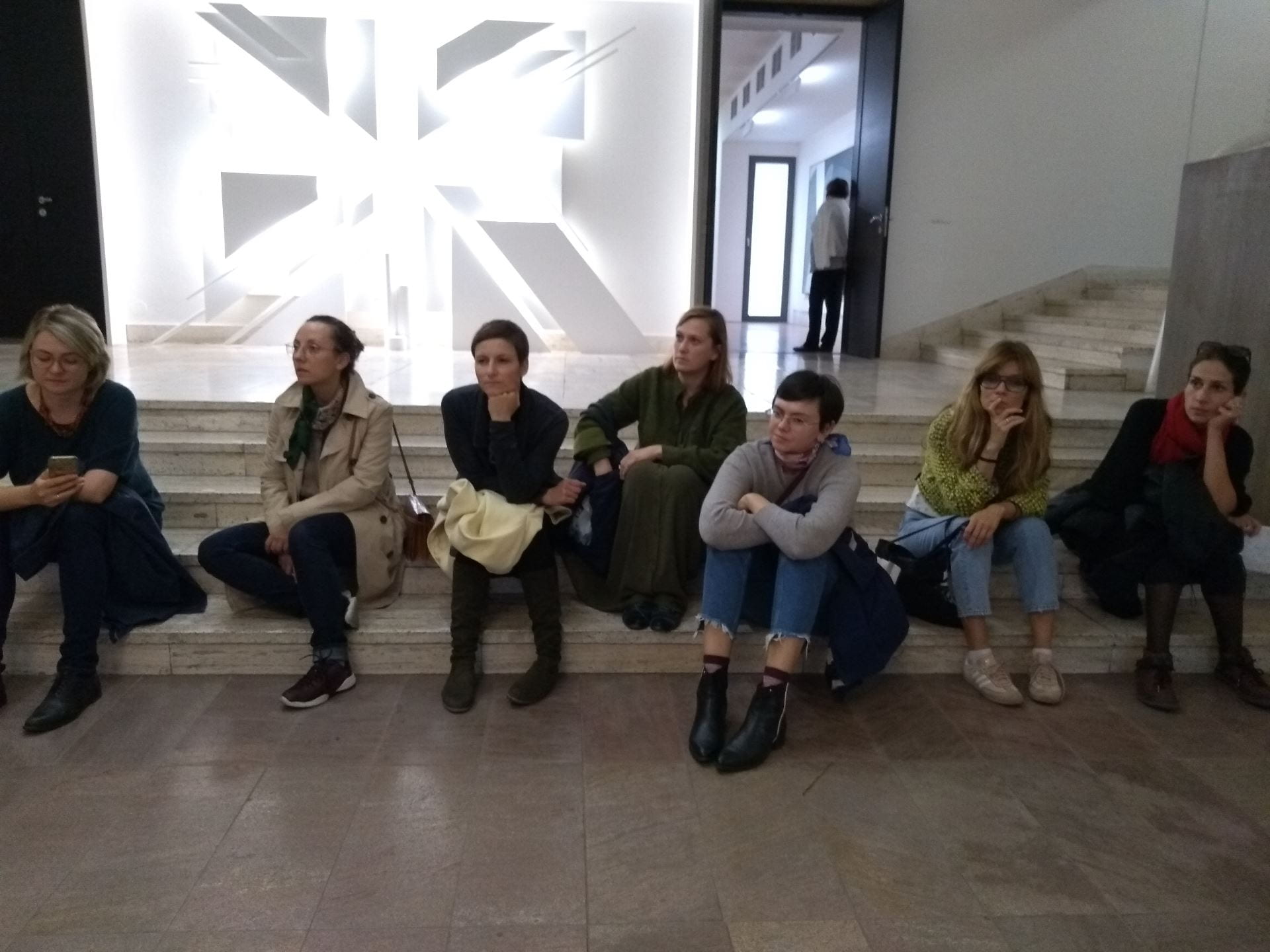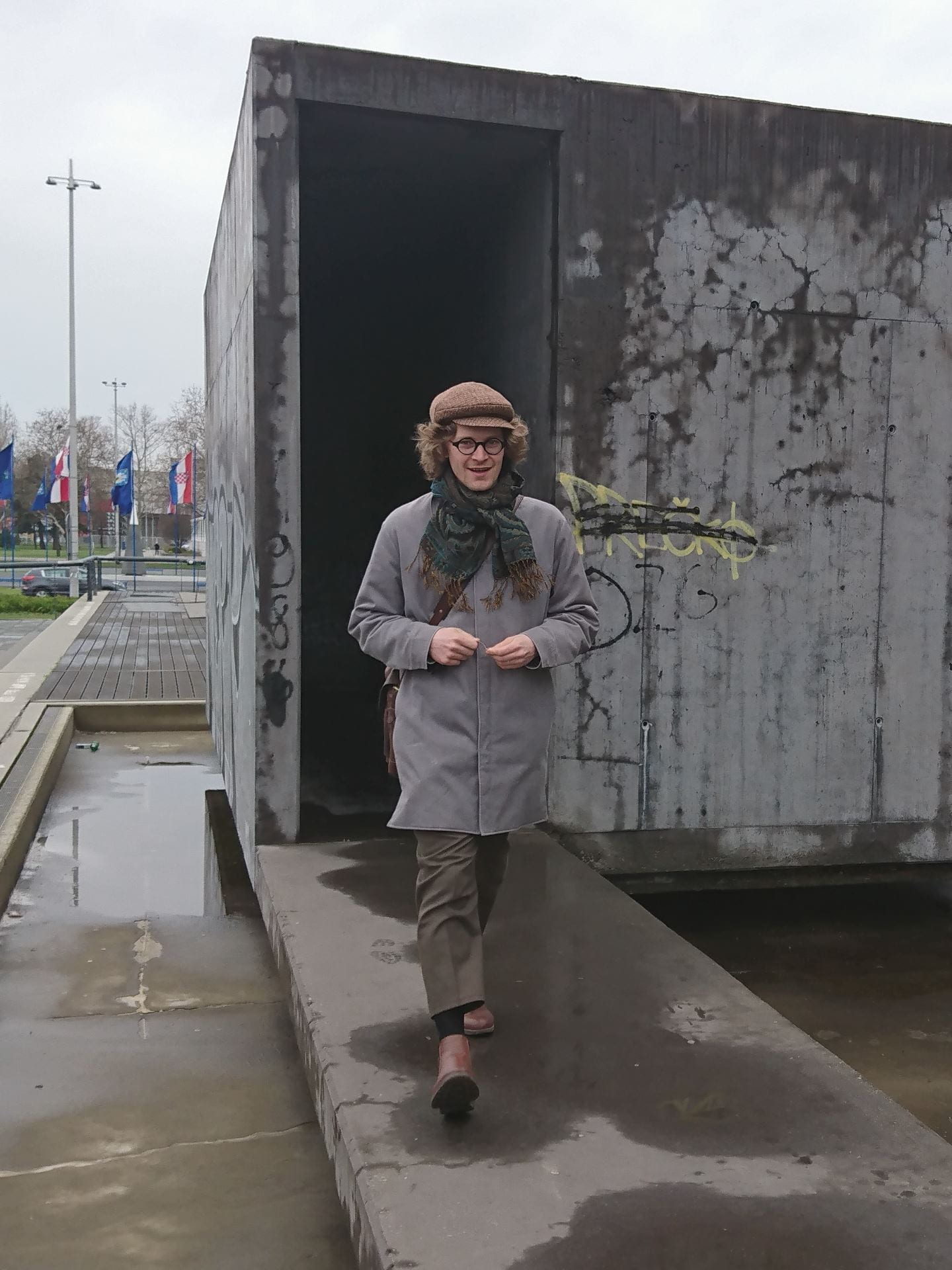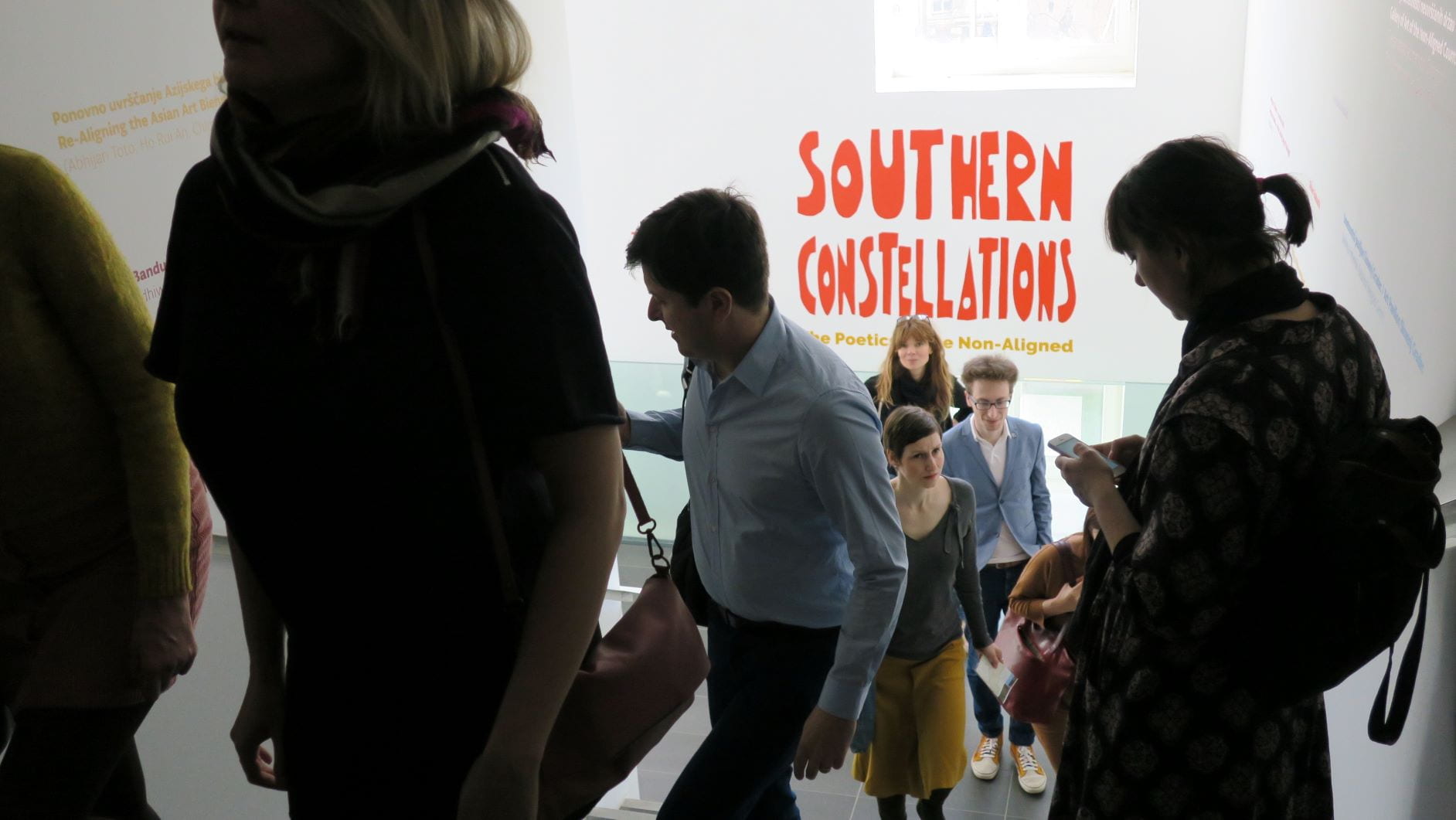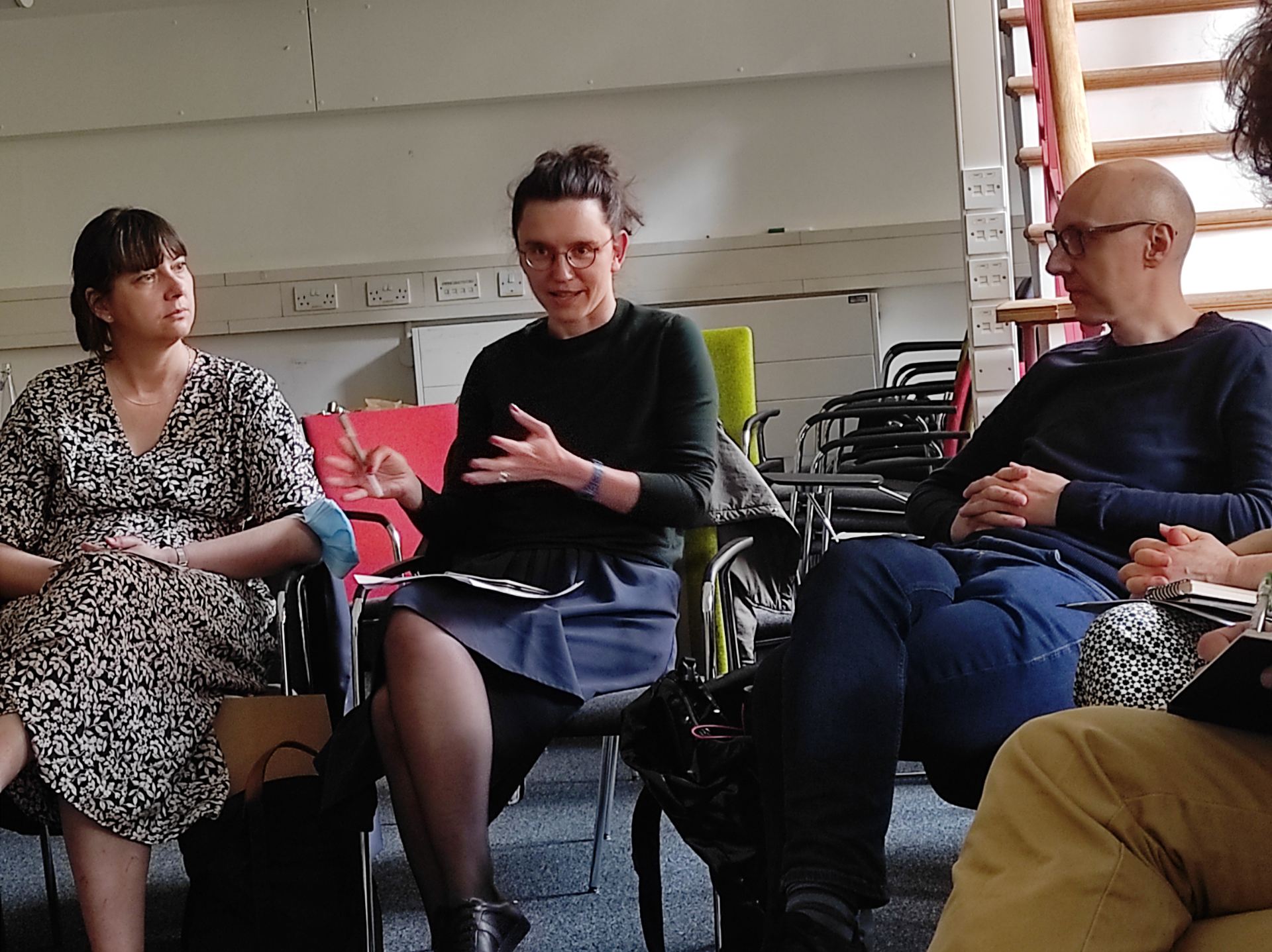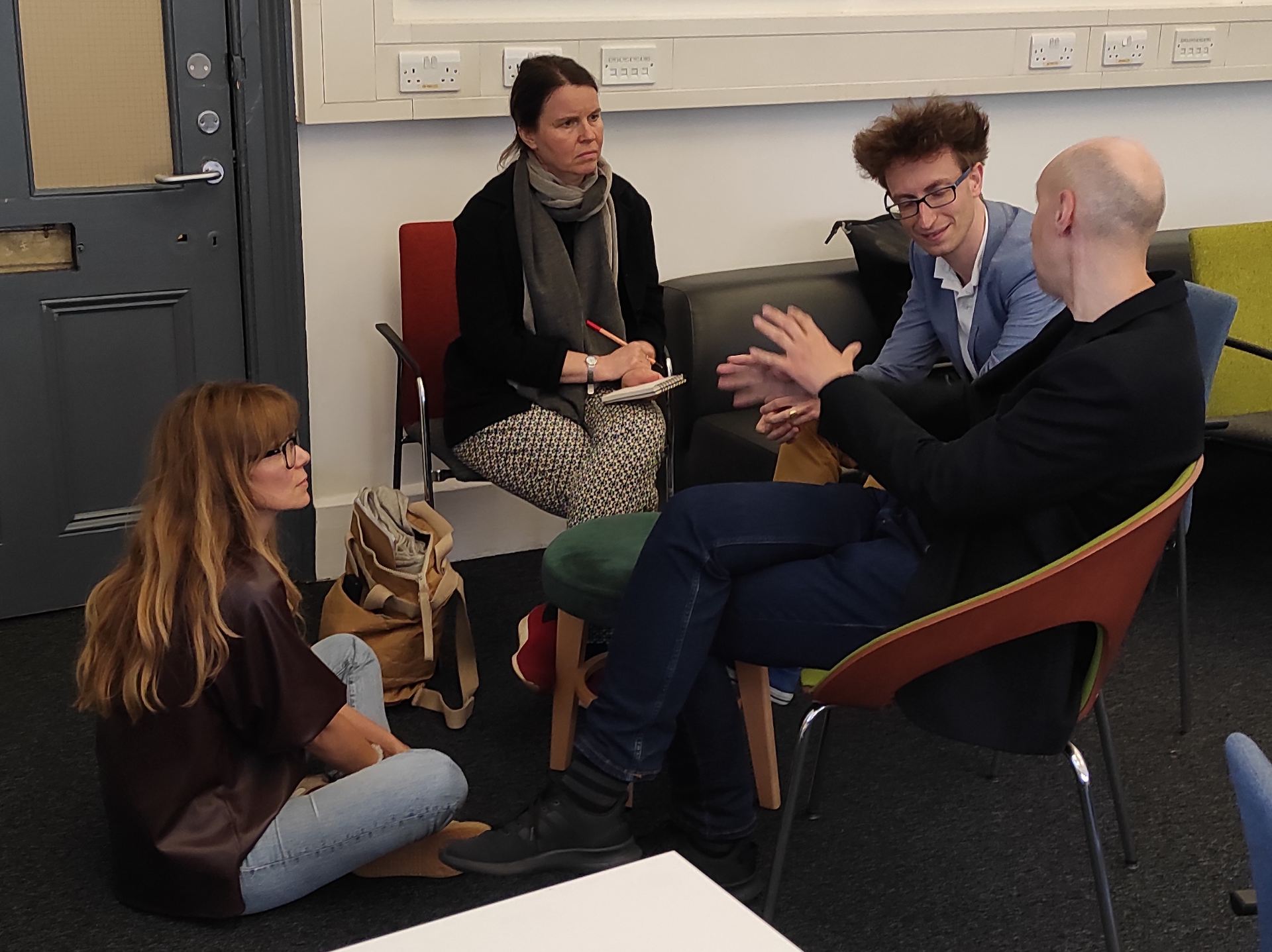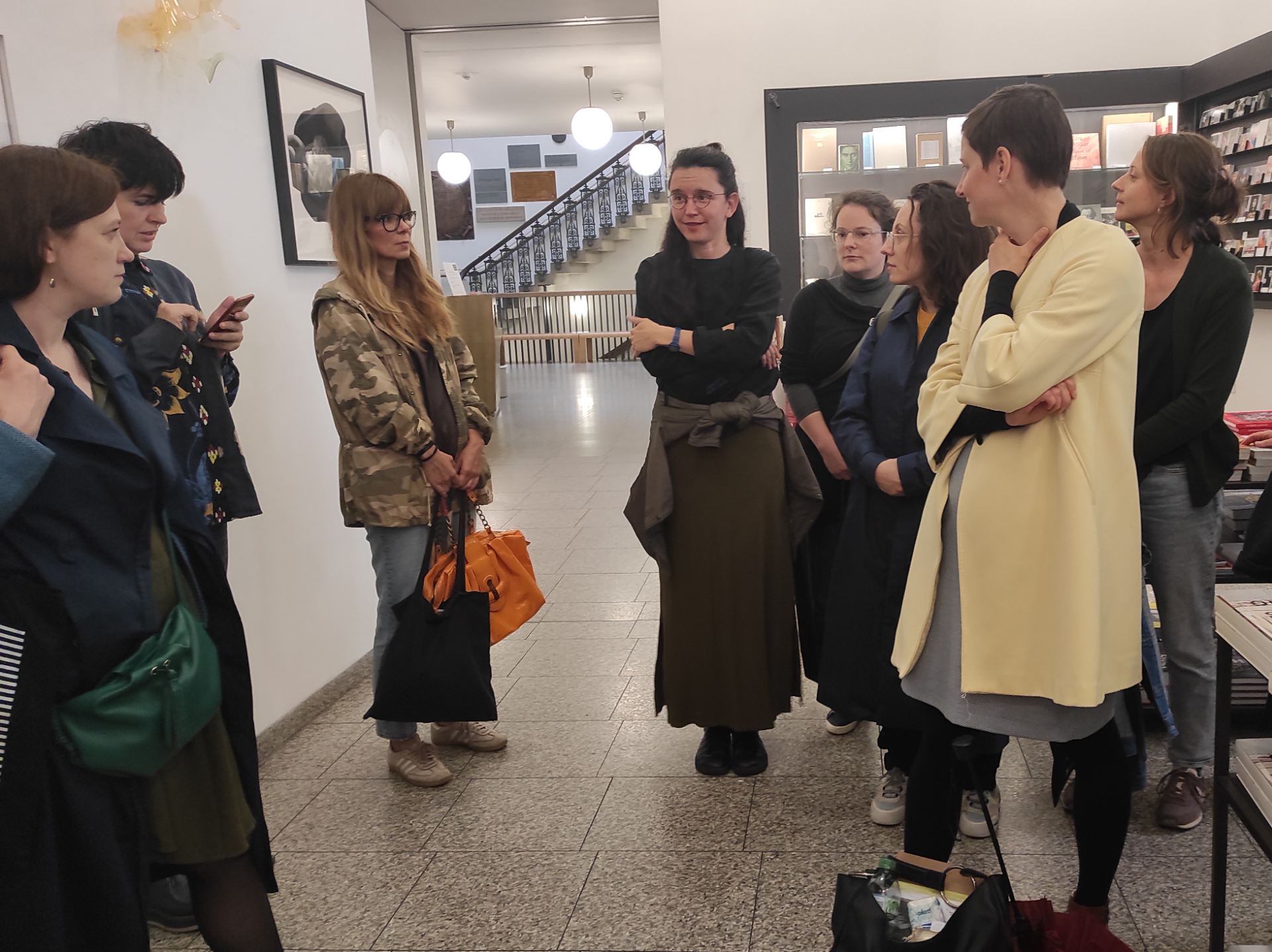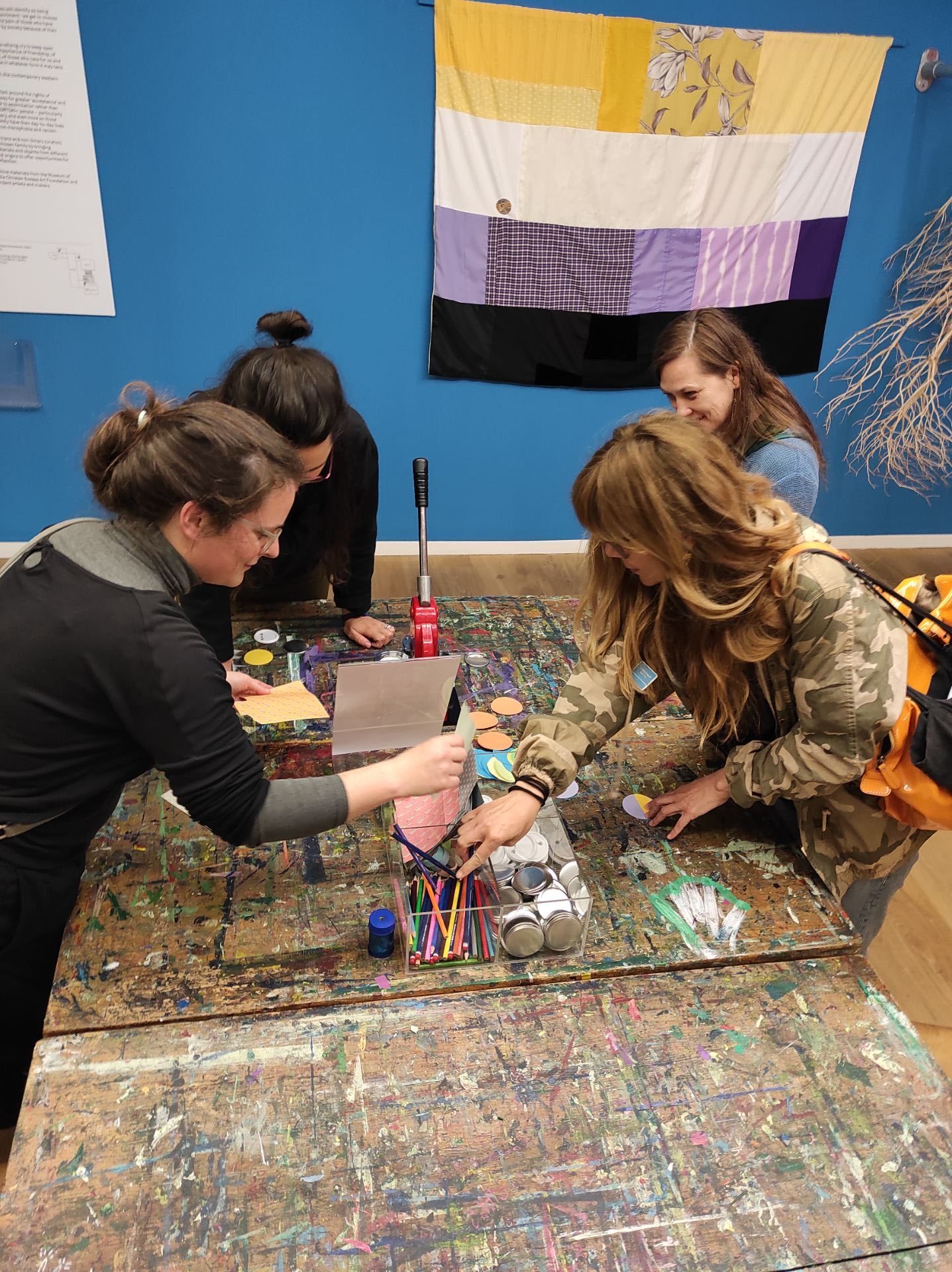Speculative Futures
By confrontations, on 5 November 2019
An open seminar at the Academy of Fine Arts set out to bring together feminist, post-socialist and decolonial perspectives on post-war national art collections, with a particular focus on the case of the National Gallery in Prague. Participants in the panel included Daniela Kramerová, who had been involved in preparing a far advanced proposal for rehanging the modern and contemporary collection of the gallery that was eventually cancelled. She used the opportunity to present her working version in public and disclose the curatorial processes behind such a task, as well as the pressure exerted by the museum management. Julia Bailey, as a representative of the National Gallery, shared her delicate perspective as a non-native curator working on the Czech national collection, as well as attempts to bring in international experience of diversifying arts funding. Karina Kottová represented the views of the collectively founded Feminist Art Institution, encouraging the audience to imagine what a feminist approach would mean in terms of the praxis of the National Gallery, while also extending solidarity to unrepresented groups within the national canon, such as Roma artists. Finally Jan Skřivánek also contributed to the discussion of how to incorporate diverse art practise into museum collections and offer new interpretations of Czech art history through non-traditional exhibition displays.
(Maja & Reuben Fowkes)
The panel discussion ‘Questioning the National Collection’ demonstrated the difficulties and to some extent the failure to establish a discourse or narration of the post war period. It became obvious that the shadows of the present are overlapping with the past and vice versa. Once again, this panel discussion revealed the process of constructing history and history as a construction. It also showed that the construction of history reflects much more the present and its actual debates. Therefore, it draws much more a picture of the present than of the past.
(Constanze Fritzsch)
Brno: Art Was There
By confrontations, on 5 November 2019
In the middle of Confrontations seminar, on the way between Prague and Bratislava, we spent the whole day in Brno, that turned out to be not just a transit point between Czech and Slovak art scenes, but also an inspiring place to explore some episodes and protagonists of these scenes more closely. ‘Art is Here’ claimed the title of the exhibition at Moravian Gallery in Brno. After the large premises of the Trade Fair Palace, National Gallery in Prague, which even through its architecture revealed the complexities of dealing with the art history of the recent past, the Moravian Gallery in Brno was pleasantly approachable and appealing with unconventional details of the display design. For instance, in the modern and inter-war-avant-garde art section, under each painting, right on the wall is a black and white reproduction of the work in question – so that if works are out of the gallery premises, on loan or restauration, visitors can still see them.
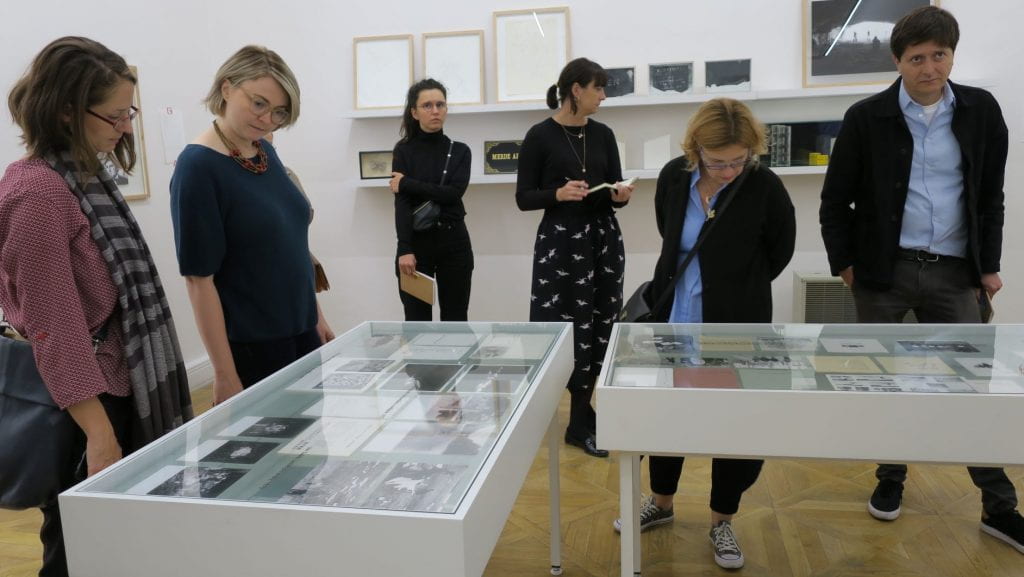 Most striking was the diversity and uncompromising character of these nonofficial art scenes in spite of political pressure after 1968, and the connections Valoch had with Czech, Slovak and international artists. Each of the exposition rooms maps the different roles Jiří Valoch had – the ones of curator, organizer, artist, theoretician, networker or collector. For me the most telling was the room that introduces Valoch as a collector: a reconstruction of the situation in his flat that is overcrowded with artworks, commenting on Valoch’s very passionate engagement, where the boundaries between life and art are more than blurred.
Most striking was the diversity and uncompromising character of these nonofficial art scenes in spite of political pressure after 1968, and the connections Valoch had with Czech, Slovak and international artists. Each of the exposition rooms maps the different roles Jiří Valoch had – the ones of curator, organizer, artist, theoretician, networker or collector. For me the most telling was the room that introduces Valoch as a collector: a reconstruction of the situation in his flat that is overcrowded with artworks, commenting on Valoch’s very passionate engagement, where the boundaries between life and art are more than blurred.
(Ieva Astahovska)
 The group’s visit to Brno revolved around the figure of the artist, curator, and theoretician Jiří Valoch, who played a central role in the development and promotion of experimental art from the mid-1960s onwards, in Brno itself and also in a broader context. Thanks to the curator Ondřej Chrobák, we were able to see how Valoch’s collection (consisting of documents, artworks and objects) is featured in the new permanent exhibition “ART IS HERE: New Art” at the Moravian Gallery-Prazak Palace. The discussions focused on the display, artists’ strategies to enable interaction in the context of political normalisation in Czechoslovakia, as well as Valoch’s less known facet as an art collector. As he was actively involved both in local organisations such as the Brno House of Arts and in international networks, Valoch’s activities were particularly emblematic of the overlapping or coexistence of the official and unofficial spheres, a subject that was at the heart of the discussions in this second session of Confrontations.
The group’s visit to Brno revolved around the figure of the artist, curator, and theoretician Jiří Valoch, who played a central role in the development and promotion of experimental art from the mid-1960s onwards, in Brno itself and also in a broader context. Thanks to the curator Ondřej Chrobák, we were able to see how Valoch’s collection (consisting of documents, artworks and objects) is featured in the new permanent exhibition “ART IS HERE: New Art” at the Moravian Gallery-Prazak Palace. The discussions focused on the display, artists’ strategies to enable interaction in the context of political normalisation in Czechoslovakia, as well as Valoch’s less known facet as an art collector. As he was actively involved both in local organisations such as the Brno House of Arts and in international networks, Valoch’s activities were particularly emblematic of the overlapping or coexistence of the official and unofficial spheres, a subject that was at the heart of the discussions in this second session of Confrontations.
This was followed by another fascinating visit, this time to the part of the Jiří Valoch Archive that is conserved at the Moravian Gallery’s Governor’s Palace. The curator Jana Písaříková offered us an overview of the large amount of material held at the gallery, reflecting the artist’s connections and interests over more than four decades. One of the challenges the Archive currently faces is the need to design an organizational structure for materials from an artist who was never interested in self-archiving. There is no doubt that the whole complex is fertile ground still to be explored!
(Juliane Debeusscher)
Archiving Valoch
By confrontations, on 5 November 2019
For many decades Jiří Valoch has been a “living institution”. He combined different roles in his professional career: a poet, musician, visual and textual artist, art critic, theoretician and curator, artistic culture organizer, pedagogue, art collector and archive builder. He is also an exemplary figure for the “Confrontations: Sessions in East European Art History” research project in so far as he managed, between 1960 and 1990, to create and animate a vast transnational network of contacts, exchange and cooperation, not only with partners from other countries of the Eastern bloc but also from Western and Southern Europe or Latin America.
The thing that bears the greatest testimony to Valoch’s networking activities is his vast archive of art documentation, letters, exhibition catalogues and books on art. Regrettably enough, the archive – along with his art collection – is now divided and deposited in a number of places, the most important parts being kept in the Moravian Gallery in Brno, the J. H. Kocman Archive and the National Gallery in Prague. At present, one can hardly imagine an actual institution which would reintegrate Valoch’s dispersed heritage, be devoted to commemorating his multifarious achievements and take them as a reference point for its own contemporary concept, mission and programme. Yet it is exactly such an institution – or an interinstitutional cooperation project – that would be the right site to present the totality of Valoch’s transnational networking activities, at least in the form of a temporary exhibition.
During our visit to the Moravian Gallery in Brno we also had a chance to see the Jiří Valoch Archive itself. It was an unforgettable experience: a long corridor-like room with rows of book cases and card boxes filled with all kind of archival items, with a characteristic smell of old paper and a feeling of hopelessness in the face of an unorderly overabundance of research material. As we were informed by the curator of the archive, Jana Písaříková, the gallery team are indeed at the very beginning of systematic ordering and tagging of the items and researching their content. The situation reminded us about other archives of East European art that are still being discovered or made available for exploration and, more generally, about how much primary sources research is still to be performed here. Contrary to some beliefs, we are not done with it and cannot simply proceed to a next stage of synthetic and comparative analyses. Both, it seems, must be done at the same time.
(Tomasz Załuski)
Popularising Pištěk
By confrontations, on 5 November 2019
A visit to the Brno House of Arts gave the Confrontations participants the chance to encounter an artistic oeuvre that sits uneasily within the dichotomies of official and unofficial art, as well as the divide between experimental and mainstream taste. A large-scale solo show of the work of Theodor Pištěk elicited mostly bemusement on the part of the group, encountering unexpectedly the sculpture and paintings of an artist who was educated in the Prague Academy of Applied Arts at the height of Socialist Realism, had a parallel career as a racing car driver, and is best known by the Czech public for his achievements as a costume designer in the film industry. Presented here were both his glossy and futuristic abstract canvases from the 1960s and his equally glossy, hyperrealist paintings from the 1970s and 1980s. These tableaus are filled with racing car drivers, unsettling depictions of exotic natives and pin up girls, as well as streamlined machines and other icons of the technological sublime; a fantasy world that posed no threat to the Normalisation regime, but still tugged at the sub-conscious of socialist citizens. Indicative of changing artworld criteria is the fact that a popular figure like Pištěk could get the full retrospective treatment in a hallowed venue of progressive and conceptual art, where Valoch worked as a curator from the early 1970s.
(Maja & Reuben Fowkes)
Library Seminar
By confrontations, on 5 November 2019
Further group seminars expanded the discussion away from Czechoslovak art histories, bringing perspectives from Bulgarian, Romanian, Estonian and Latvian art contexts.
Dessislava Dimova examined the practice of Vladimir Ivanov from the 1970s and 1980s to open up the debate around the supposed lack of modernist and neo-avant-garde traditions in Bulgaria, pointing to the interchangeability of abstract lines and human figures.
 Corina Apostol focused on the period of the 1980s, problematising the porous divide between the official art of the late socialist period in Romania and the critical and artistic strategies that bridged activism, community art, performance and social practice.
Corina Apostol focused on the period of the 1980s, problematising the porous divide between the official art of the late socialist period in Romania and the critical and artistic strategies that bridged activism, community art, performance and social practice.
 Gregor Taul shared his research into Soviet monumental decorative art, in tracking down surviving murals and designs in often derelict public buildings and factories and returning to them a systematic art historical analysis, befitting historical works of public art that deserve to be preserved and restored rather than allowed to deteriorate and disappear.
Gregor Taul shared his research into Soviet monumental decorative art, in tracking down surviving murals and designs in often derelict public buildings and factories and returning to them a systematic art historical analysis, befitting historical works of public art that deserve to be preserved and restored rather than allowed to deteriorate and disappear.

Ieva Astahovska examined the trajectory of the notion of Baltic art as a distinct branch of East European art through international exhibitions and biennials, exploring its importance for the development of a post-Soviet regional identity.
(MRF)
Interrupted Song
By confrontations, on 5 November 2019
What does Czechoslovak Socialist Realism look like? Alexandra Kusá, director of the Slovak National Gallery in Bratislava and curator of the 2012 exhibition “Interrupted Song: The Art of Socialist Realism 1948-1956” showed us a number of atypical examples, both in content and form. We saw a Stalin at a museum, looking at a baroque painting; another one listening to a classical music concert; a double portrait of two men swimming together in a visibly homoerotic embrace. Other pieces, though typical in their topics characteristic for Socialist Realism — they were painting and sculptures depicting scenes of factory work or crop gathering — used surprising visual language, either indebted to the great masters like Giotto and Piero della Francesca, or even clearly referencing “debased” modern art styles, such as cubism!
The challenge posed by the Czechoslovak Socialist Realism, however, is grounded not only in iconography or stylistic considerations. Just like with the more general history of art from the communist period, there is a degree of difficulty with discussing what was actually Czecho-Slovak about this art.
Even though Czechoslovakia was a single country for almost five postwar decades, with a single state Artists Union serving all practitioners in the federation, the scenes in Prague and Bratislava remained largely separate. And especially after the split of 1993, there seems to be general pressure to consider the cultural history of Czechia and Slovakia independently from each other. Kusá admitted to us that this issue, and related tensions, stalled her work on the project for an extended period of time. Finally, she decided to deal with this issue in a conceptual manner: In a book Perusena Pesen: Vytvarne Umenie w Casoch Stalinskej Kulturnej Praxe that she published in 2019, she included examples of artworks from the Czech part of the federation among those made by Slovak artists, but had all those objects captioned in the Czech, rather than Slovak, language. “There were fights with the copy editor, but I won!” she told our group.
(Magdalena Moskalewicz)
Socialist Realism Beyond Humour
By confrontations, on 5 November 2019
During our trip to Prague and Bratislava we were confronted with different approaches to the artistic production of socialist realism. During our first session in Prague, Tomáš Pospiszyl presented us the theoretical premises of his new research project dedicated to the official art of the socialist era. The art historian emphasised that it is important to step outside art history’s comfort zone of modernism and neo-avantgarde in order to turn to practices that are aesthetically more challenging. The study of conditions of production of officially sanctioned art can also change our understanding of the practices that were contesting it.
The theoretical framework presented by Pospiszyl created a stimulating discussion and made us eager to confront the socialist realist art works in question. How bad could they be? At that stage, armed with arguments we were prepared to confront smiling faces of multiple Lenins and Stalins. However, the display at the National Gallery in Prague left us empty-handed as it turned out socialist realist art was removed from a small room dedicated to it in a previous version of the display. We were told that the arrangement was rather stereotypical in depicting socialist realism as failed, political kitsch.
In Bratislava, we saw a different approach to socialist realism. During her presentation, the director of the Slovak National Gallery, Alexandra Kusá presented to us her exhibition and book titled “Prerušená pieseň” (“Interrupted Song”) dedicated to the official art of the period between 1945 and 1956. The curator’s approach was distanced from any moral and aesthetic judgement on art of that time. However, as we soon discovered by breaking into collective laughter when confronted with some examples of badly executed socialist realist painting, it is hard to look at socialist realism from today’s perspective without any sense of humour. Yet, reaching beyond the comic effects of some art works, Kusá’s talk discussed conditions of art making under Stalinism, exposing motivations and social factors at work. The comprehensive catalogue constitutes a rich resource of images and documents relating to the period. It will be really interesting to see how this research will be articulated in the new display of the Gallery’s permanent collection.
(Agata Pietrasik)
Nothing Can Stop Us!
By confrontations, on 5 November 2019
 I will remember the Slovak National Gallery in Bratislava as a space of stimulating intellectual exchange, punctuated by surprise and laughter. The two days of presentations and discussions at the Kornel and Nada Földvari Library on the Gallery’s first floor bear the mark of the disturbingly hilarious presence of a beautiful stuffed horse, poised next to the larger-than-life portrait of Mr. Földvari dressed as an “Indian.” Despite Földvari’s evident passion for the “Wild West,” the horse was not his idea, but was placed there as a nod to the stuffed giraffe dominating the entrance of the Natural History Museum since socialist times. This same giraffe was supposed to become an inhabitant of the Bratislava Zoo but died upon arrival, ending up as an enduring, and most popular, museum exhibit.
I will remember the Slovak National Gallery in Bratislava as a space of stimulating intellectual exchange, punctuated by surprise and laughter. The two days of presentations and discussions at the Kornel and Nada Földvari Library on the Gallery’s first floor bear the mark of the disturbingly hilarious presence of a beautiful stuffed horse, poised next to the larger-than-life portrait of Mr. Földvari dressed as an “Indian.” Despite Földvari’s evident passion for the “Wild West,” the horse was not his idea, but was placed there as a nod to the stuffed giraffe dominating the entrance of the Natural History Museum since socialist times. This same giraffe was supposed to become an inhabitant of the Bratislava Zoo but died upon arrival, ending up as an enduring, and most popular, museum exhibit.
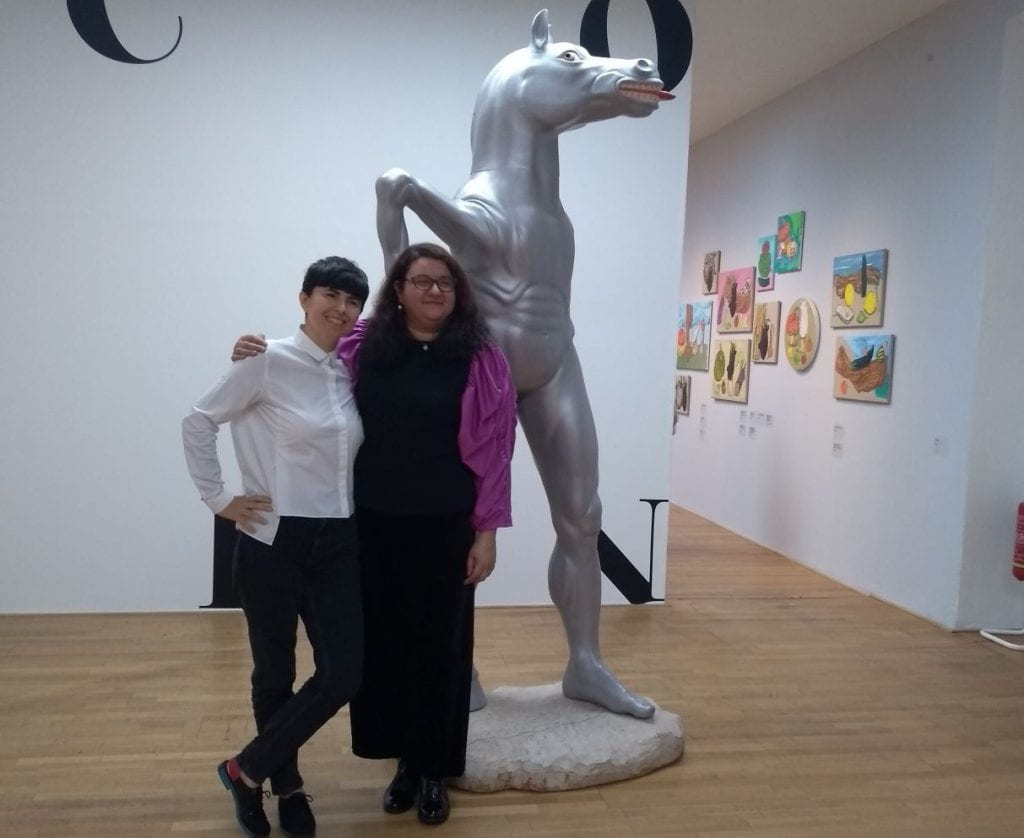 Things seemed to reach their logical conclusion on the second floor of the Gallery, where Nothing Can Stop Us, a retrospective exhibition of the Slovak pioneer of “new expressionism,” Laco Teren, opened with a sculpture of a laughing horse, or rather, an upside-down centaur, a creature with human legs and equine torso and head, sticking out his tongue at the visitors. Tongue-in-cheek indeed best describes this exquisitely installed exhibition, curated by Katarína Bajcurová, who gave us a tour. The blazing colors of Teren’s paintings and his humorous, cocky, end-of-history reshuffling of symbols of class struggle and socialism look like Laibach/Irwin on LSD, as if to suggest the need to not simply end, but to thoroughly launch ourselves out of history, laughing.
Things seemed to reach their logical conclusion on the second floor of the Gallery, where Nothing Can Stop Us, a retrospective exhibition of the Slovak pioneer of “new expressionism,” Laco Teren, opened with a sculpture of a laughing horse, or rather, an upside-down centaur, a creature with human legs and equine torso and head, sticking out his tongue at the visitors. Tongue-in-cheek indeed best describes this exquisitely installed exhibition, curated by Katarína Bajcurová, who gave us a tour. The blazing colors of Teren’s paintings and his humorous, cocky, end-of-history reshuffling of symbols of class struggle and socialism look like Laibach/Irwin on LSD, as if to suggest the need to not simply end, but to thoroughly launch ourselves out of history, laughing.
 I guess our itinerant quest for Eastern European, socialist art in Confrontations is something of a hybrid of the two horses: one negotiating with the geocultural crossdressing and taxidermy of the socialist past, and the other exploding it in order to transform it into some as yet-unseen but exhilarating future. Nothing can stop us!
I guess our itinerant quest for Eastern European, socialist art in Confrontations is something of a hybrid of the two horses: one negotiating with the geocultural crossdressing and taxidermy of the socialist past, and the other exploding it in order to transform it into some as yet-unseen but exhilarating future. Nothing can stop us!
(Ivana Bago)
Introducing Syzygia
By confrontations, on 5 November 2019
 We were joined by two members of the Syzygia group, Rudolf Sikora and Gabriel Hošovský, for a working dinner to reflect on the intergenerational and cooperative spirit of the Bratislava art scene at the end of the 1980s. Founded in 1986 by four younger artists and Sikora, the name Syzýgia derived from the astronomical term for contradictory phenomena, which stood here for the local conflict between modernist and postmodernist outlooks. Standing up against ideological control, their shows, originally held in the older artists’ studios, offered a neo-conceptualist riposte to the neo-expressionist trend in painting. Although the group stopped exhibiting together shortly after the revolution of 1989, their collaborative achievements are documented in a bilingual catalogue, which the editor Lýdia Pribišová introduced to the Confrontations participants.
We were joined by two members of the Syzygia group, Rudolf Sikora and Gabriel Hošovský, for a working dinner to reflect on the intergenerational and cooperative spirit of the Bratislava art scene at the end of the 1980s. Founded in 1986 by four younger artists and Sikora, the name Syzýgia derived from the astronomical term for contradictory phenomena, which stood here for the local conflict between modernist and postmodernist outlooks. Standing up against ideological control, their shows, originally held in the older artists’ studios, offered a neo-conceptualist riposte to the neo-expressionist trend in painting. Although the group stopped exhibiting together shortly after the revolution of 1989, their collaborative achievements are documented in a bilingual catalogue, which the editor Lýdia Pribišová introduced to the Confrontations participants.
(MRF)
Pop Variants
By confrontations, on 5 November 2019
 With the permanent collection of the Slovak National Gallery currently closed for major reconstruction, we headed to the Gallery of the City of Bratislava for a direct if fragmentary encounter with works by canonical Slovak artists of the 1960s. We were joined by art historian Richard Gregor, who shared with the group his experiences of researching Slovak Pop Art and integrating his work within the changing international discourse around the movement, as it exchanges its West-centric assumptions for a global perspective. His insights into the Slovak side of the first Confrontations exhibitions in Bratislava also offered a more complex and reciprocal account of Czech and Slovak artistic relations in the early 1960s.
With the permanent collection of the Slovak National Gallery currently closed for major reconstruction, we headed to the Gallery of the City of Bratislava for a direct if fragmentary encounter with works by canonical Slovak artists of the 1960s. We were joined by art historian Richard Gregor, who shared with the group his experiences of researching Slovak Pop Art and integrating his work within the changing international discourse around the movement, as it exchanges its West-centric assumptions for a global perspective. His insights into the Slovak side of the first Confrontations exhibitions in Bratislava also offered a more complex and reciprocal account of Czech and Slovak artistic relations in the early 1960s.
(MRF)
Made in 1989
By confrontations, on 5 November 2019
 A visit to Gandy Gallery took us to the very end of the research period of Confrontations: Sessions in East European Art History, since their current exhibition to mark the 30th anniversary of the Velvet Revolution featured the work made in the year 1989 by women artists. This select group included Ilona Németh and Anna Daučíková from Slovakia and Lia Perjovschi from Romania. Marysia Lewandowska showed Empty Chair (1989), pictured below, which referenced two women who took part in the Round Table Talks in Poland in spring of that year, questioning the instability of representation and the role of women in historical events.
A visit to Gandy Gallery took us to the very end of the research period of Confrontations: Sessions in East European Art History, since their current exhibition to mark the 30th anniversary of the Velvet Revolution featured the work made in the year 1989 by women artists. This select group included Ilona Németh and Anna Daučíková from Slovakia and Lia Perjovschi from Romania. Marysia Lewandowska showed Empty Chair (1989), pictured below, which referenced two women who took part in the Round Table Talks in Poland in spring of that year, questioning the instability of representation and the role of women in historical events.
Slovak Lessons in Late Socialism
By confrontations, on 5 November 2019
Guest lectures by Slovak art historian Ján Kralovič and curator Mira Keratová gave the group the opportunity to become immersed in the specificities of the art histories of the late 1970s and 1980s in Bratislava and the life and work of artists whose careers traversed the period from Normalisation to the Velvet Revolution.
Mira Keratová focused in her presentation on Ján Budaj, an artist whose attempts to cross closed international borders brought him into contact with the secret police, religious groups and alternative communities in Slovakia and abroad. She also shed light on his influential role in the Velvet Revolution as a leading figure in the environmental and civic protest movements of the 1980s, including as a producer of samizdat publications and initiator of the group Temporary Society of Intense Experience.
Ján Kralovič took the group on a virtual journey from the 1970s to the 1980s in the alternative scene of Bratislava, sharing with us rare images of the ephemeral exhibition spaces set up in the homes of artists. The questions raised by the Confrontations participants included how official attitudes to rebellious artist collectives and non-official spaces changed between the 1970s and 1980s, with Kralovič pointing to 1986 as the threshold year, after which there was no longer a compulsion for experimental artists to take shelter from the authorities in under-the-radar apartment galleries.
(MRF)
Setting the Confrontations Agenda
By confrontations, on 29 April 2019
 The first session of Confrontations kicked off with a circle of introductions of this select group of scholars of East European art history, coming together at the beginning of an ambitious programme of collective research. Hosted by the Museum of Contemporary Art Zagreb, the first gathering was an opportunity to introduce the agenda of Confrontations over the coming years, with the aim to uncover the contested histories of the art of the first and last decades of the socialist period across the diverse art scenes of Eastern Europe.
The first session of Confrontations kicked off with a circle of introductions of this select group of scholars of East European art history, coming together at the beginning of an ambitious programme of collective research. Hosted by the Museum of Contemporary Art Zagreb, the first gathering was an opportunity to introduce the agenda of Confrontations over the coming years, with the aim to uncover the contested histories of the art of the first and last decades of the socialist period across the diverse art scenes of Eastern Europe.  Anticipating from the outset the complexity and potential irreconcilability of certain positions in contested art historical evaluations, the participants were invited to confront their views through a symbolic Tug of Art History. The question that saw the group take the most opposing positions indicatively was whether abstract art could be seen as a propaganda tool of the socialist state. Intended as a gesture to establish a safe environment for the expression of discordant points of view, this group exercise was also an indication of the objective of Confrontations to activate the potential of ‘sensuous scholarship’ through an embodied art history in which researchers are immersed in direct experiences, exchanges and encounters with the objects of study in situ.
Anticipating from the outset the complexity and potential irreconcilability of certain positions in contested art historical evaluations, the participants were invited to confront their views through a symbolic Tug of Art History. The question that saw the group take the most opposing positions indicatively was whether abstract art could be seen as a propaganda tool of the socialist state. Intended as a gesture to establish a safe environment for the expression of discordant points of view, this group exercise was also an indication of the objective of Confrontations to activate the potential of ‘sensuous scholarship’ through an embodied art history in which researchers are immersed in direct experiences, exchanges and encounters with the objects of study in situ. 
 The first group seminar vividly illustrated the plurality and wealth of approaches in response to the task of proposing their own working definition of East European art history. As we went around the table, it was clear that everyone had interpreted the brief set out in advance by the convenors of Confrontations differently. In that sense, attempts to define our research area ranged from historicising the question of East European art, either relegating it to the pre-1989 state-socialist period or conceiving it as a post-1989 construct, to putting forward theoretical or linguistic distillations of the field. Also voiced was the notion that focusing on Eastern European art could be a strategic choice, in terms of pursuing particular ethical or decolonising agendas with regard to art history.
The first group seminar vividly illustrated the plurality and wealth of approaches in response to the task of proposing their own working definition of East European art history. As we went around the table, it was clear that everyone had interpreted the brief set out in advance by the convenors of Confrontations differently. In that sense, attempts to define our research area ranged from historicising the question of East European art, either relegating it to the pre-1989 state-socialist period or conceiving it as a post-1989 construct, to putting forward theoretical or linguistic distillations of the field. Also voiced was the notion that focusing on Eastern European art could be a strategic choice, in terms of pursuing particular ethical or decolonising agendas with regard to art history.

(MRF)
Tomislav Gotovac Institute
By confrontations, on 29 April 2019
 After intensive discussions at MSU and pulling of the rope, we ended in the Krajiška street 29 in the former apartment of Tomislav Gotovac. Welcomed by Darko Šimičić, co-founder of the Institute and secretary of the artist’s archive, along with Zora Gotovac and daughter Sarah, we could follow Gotovac’s fascinating journey from experimental films, photostories towards performance art.
After intensive discussions at MSU and pulling of the rope, we ended in the Krajiška street 29 in the former apartment of Tomislav Gotovac. Welcomed by Darko Šimičić, co-founder of the Institute and secretary of the artist’s archive, along with Zora Gotovac and daughter Sarah, we could follow Gotovac’s fascinating journey from experimental films, photostories towards performance art.
 In the authentic settings of the artist’s apartment and the studio we were able to understand the birth of a visual artist using expanded media in the unique situation of Croatia since the 1960s. Gotovac’s case is one of the examples of artistic trajectories behind the Iron Curtain, influenced by politics, social change and personal standings. He was a key member of the Yugoslav neo-avant-garde and exhibited in 1976 for the first time after 15 years of continuous work. He created series of photographs, collages, a number of experimental films and famous performances.
In the authentic settings of the artist’s apartment and the studio we were able to understand the birth of a visual artist using expanded media in the unique situation of Croatia since the 1960s. Gotovac’s case is one of the examples of artistic trajectories behind the Iron Curtain, influenced by politics, social change and personal standings. He was a key member of the Yugoslav neo-avant-garde and exhibited in 1976 for the first time after 15 years of continuous work. He created series of photographs, collages, a number of experimental films and famous performances.
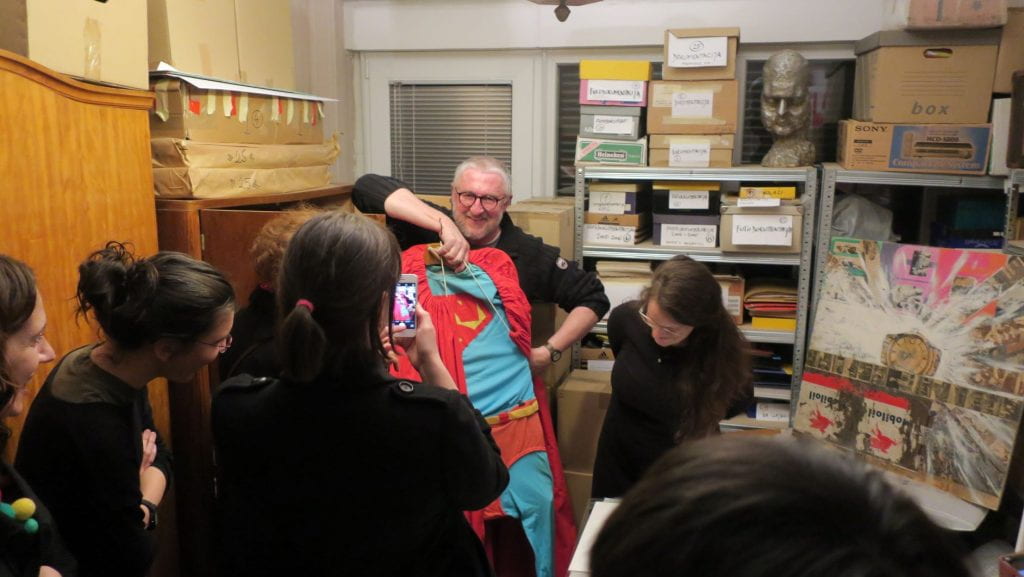 The visit of the artist’s kitchen was an experience of its own – Gotovac’s Yugoslav Merzbau is an original and very personal collage in the space. And when Darko Šimičić pulled out of one of the closets Gotovac’s batman suite made by Zora Gotovac from underwear, we were hooked.
The visit of the artist’s kitchen was an experience of its own – Gotovac’s Yugoslav Merzbau is an original and very personal collage in the space. And when Darko Šimičić pulled out of one of the closets Gotovac’s batman suite made by Zora Gotovac from underwear, we were hooked.
(Pavlína Morganová)
Pluralising Yugoslav Art
By confrontations, on 29 April 2019
 A constitutive element of the Confrontations sessions are peer seminars at which the members succinctly present their research related to the particular focus of the programme and then respond to questions and comments from the others. The first such seminar was held at the Museum of Contemporary Art in Zagreb and was focused on the uneven terrains of Yugoslav and post-Yugoslav art history, with presentations by Ivana Bago on What is Yugoslav Art?, Asja Mandić on The Centre-Periphery Relations in Socialist Yugoslavia: Multiple Art Histories and Sandra Bradvić on Jugoslovenska dokumenta (Sarajevo, 1984-1989): From ‘off-space’ to ‘big-scale-exhibition’.
A constitutive element of the Confrontations sessions are peer seminars at which the members succinctly present their research related to the particular focus of the programme and then respond to questions and comments from the others. The first such seminar was held at the Museum of Contemporary Art in Zagreb and was focused on the uneven terrains of Yugoslav and post-Yugoslav art history, with presentations by Ivana Bago on What is Yugoslav Art?, Asja Mandić on The Centre-Periphery Relations in Socialist Yugoslavia: Multiple Art Histories and Sandra Bradvić on Jugoslovenska dokumenta (Sarajevo, 1984-1989): From ‘off-space’ to ‘big-scale-exhibition’.

 Much discussion ensued over the relation between Yugoslav art history and that of the individual countries of the former socialist federation, and how to evaluate moves during the post-communist period to assimilate Yugoslav art to a wider East European account. Productive debate was also sparked over how the narrative of Yugoslav art history could be pluralised to include artists and communities who were excluded from the celebrated ‘second line’ traced in canonical accounts from EXAT51 through New Tendencies, Gorgona and the New Art Practice to the post-avant-garde formations of the 1980s.
Much discussion ensued over the relation between Yugoslav art history and that of the individual countries of the former socialist federation, and how to evaluate moves during the post-communist period to assimilate Yugoslav art to a wider East European account. Productive debate was also sparked over how the narrative of Yugoslav art history could be pluralised to include artists and communities who were excluded from the celebrated ‘second line’ traced in canonical accounts from EXAT51 through New Tendencies, Gorgona and the New Art Practice to the post-avant-garde formations of the 1980s.
(MRF)
No SR in the MSU
By confrontations, on 29 April 2019
 In light of our discussions, it was extremely instructive to have a tour of the incomparable MSU collection from curator and co-author of the display Tihomir Milovac. He shared his methodology of developing a ‘collection in motion,’ and the intricacies of approaches to abstraction in the oeuvre of EXAT51 artists and the Gorgona group.
In light of our discussions, it was extremely instructive to have a tour of the incomparable MSU collection from curator and co-author of the display Tihomir Milovac. He shared his methodology of developing a ‘collection in motion,’ and the intricacies of approaches to abstraction in the oeuvre of EXAT51 artists and the Gorgona group.

He also sympathetically fielded critical observations on particular curatorial / institutional decisions about how to represent the art of socialist times, such as why there is no Socialist Realism on display. The diplomatic response was that the museum takes 1950 as a cut-off point and that the Gallery of Contemporary Art was founded and began collecting only in 1954, so had no interest in acquiring works in this style.
 Curator Jasna Jakšić offered further illumination of the research possibilities of the collection and was of invaluable assistance in organising our time in the museum. Direct encounters with the artworks and their museological presentation created a rigorous setting for discussions and it was refreshing – and paradigm-expanding – to follow an alternative route around the collection that gravitated towards those art historical episodes that preceded and followed the heights of new art practice in the late 1960s and early 1970s.
Curator Jasna Jakšić offered further illumination of the research possibilities of the collection and was of invaluable assistance in organising our time in the museum. Direct encounters with the artworks and their museological presentation created a rigorous setting for discussions and it was refreshing – and paradigm-expanding – to follow an alternative route around the collection that gravitated towards those art historical episodes that preceded and followed the heights of new art practice in the late 1960s and early 1970s.
(MRF)
Situated Knowledge
By confrontations, on 29 April 2019
 A guest talk by artist and researcher Darko Fritz drew the group closer to the influential New Tendencies series of exhibitions and symposia held in Zagreb from 1961. In an impassioned presentation delivered in front of the works themselves, he laid out the lifecycle of the movement from inception to crisis, the local politics around New Tendencies and its relation to other artistic formations. He also addressed the way in which the movement was eventually subsumed into other stylistic categories, like Op Art, within an international context. Reflecting also his own background in New Media Art, Fritz emphasised the exceptional contribution of New Tendencies to the development of Computer Art.
A guest talk by artist and researcher Darko Fritz drew the group closer to the influential New Tendencies series of exhibitions and symposia held in Zagreb from 1961. In an impassioned presentation delivered in front of the works themselves, he laid out the lifecycle of the movement from inception to crisis, the local politics around New Tendencies and its relation to other artistic formations. He also addressed the way in which the movement was eventually subsumed into other stylistic categories, like Op Art, within an international context. Reflecting also his own background in New Media Art, Fritz emphasised the exceptional contribution of New Tendencies to the development of Computer Art.
 Another engaging talk was by curator Ivana Janković on Croatian artist Antun Motika, whose singular post-war experimental practice, involving work with organic materials and slide projections, does not easily fit into existing local art historical narratives of the period. For the participants, with their broad comparative perspective, Motika’s approach revealed unexpected points of connection with the interests of other East European artists of the post-war period in the overlaps of art, nature and science.
Another engaging talk was by curator Ivana Janković on Croatian artist Antun Motika, whose singular post-war experimental practice, involving work with organic materials and slide projections, does not easily fit into existing local art historical narratives of the period. For the participants, with their broad comparative perspective, Motika’s approach revealed unexpected points of connection with the interests of other East European artists of the post-war period in the overlaps of art, nature and science.
(MRF)
Before the Nineties
By confrontations, on 29 April 2019
 The group had a further chance to connect with the Zagreb art scene during an Open Seminar held at the Institute of Contemporary Art Zagreb. After an insightful and in depth analysis by art historian Leonida Kovač of the singular oeuvre of Edita Schubert (1947-2001), an artist whose practice still awaits international recognition, the evening carried on with an engaging conversation exploring the heterogenous streams of eighties art with curator and director of the ICA, Janka Vukmir.
The group had a further chance to connect with the Zagreb art scene during an Open Seminar held at the Institute of Contemporary Art Zagreb. After an insightful and in depth analysis by art historian Leonida Kovač of the singular oeuvre of Edita Schubert (1947-2001), an artist whose practice still awaits international recognition, the evening carried on with an engaging conversation exploring the heterogenous streams of eighties art with curator and director of the ICA, Janka Vukmir.
The issues that were addressed included the importance of alternative art venues such as the Gallery of Extended Media in providing a platform for subcultural trends and the visual arts. Furthermore, what can be salvaged from the interrupted legacy of the time before the nineties?
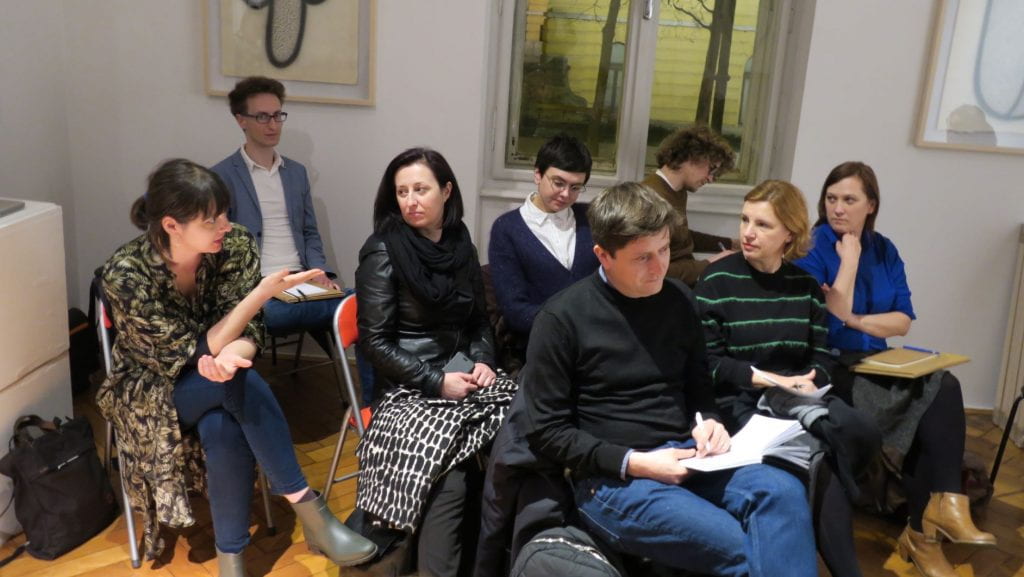 Afterwards our speakers joined us for a memorable dinner. On our last night in Zagreb, everyone was full of impressions and keen to exchange notes and deepen acquaintances with fellow members of Confrontations.
Afterwards our speakers joined us for a memorable dinner. On our last night in Zagreb, everyone was full of impressions and keen to exchange notes and deepen acquaintances with fellow members of Confrontations.
(MRF)
Institute of Art History
By confrontations, on 29 April 2019
 Still in Zagreb, next morning we visited the Institute of Art History, where the group met with art historian Sandra Križić Roban for a seminar on the history of the Institute and the art history journal, Život umjetnosti, of which until recently she was the editor in chief.
Still in Zagreb, next morning we visited the Institute of Art History, where the group met with art historian Sandra Križić Roban for a seminar on the history of the Institute and the art history journal, Život umjetnosti, of which until recently she was the editor in chief. She emphasised the role of particular individuals in determining and building up the profession of art history after the Second World War, while discussion also shifted towards the confrontation between EXAT51 and Edo Murtić over their designs for a mural in the Ritz Bar nightclub in 1953 as epitomising the struggle between competing streams of modernism in Yugoslavia after the Stalin-Tito split of 1948.
She emphasised the role of particular individuals in determining and building up the profession of art history after the Second World War, while discussion also shifted towards the confrontation between EXAT51 and Edo Murtić over their designs for a mural in the Ritz Bar nightclub in 1953 as epitomising the struggle between competing streams of modernism in Yugoslavia after the Stalin-Tito split of 1948.  We also had a tour around the building, one of the most representative achievements of socialist-era architecture and design, which opened in 1961 as the Moša Pijade Workers and Peoples University.
We also had a tour around the building, one of the most representative achievements of socialist-era architecture and design, which opened in 1961 as the Moša Pijade Workers and Peoples University. 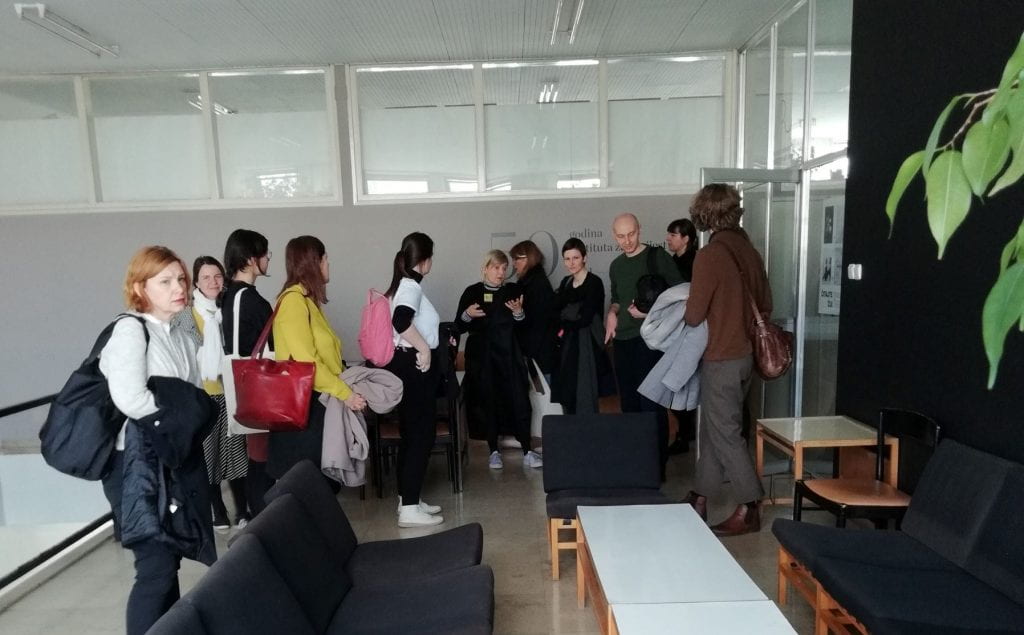
 The tour even took us into the basement of the institution, a trapdoor into a past world and a reminder that the infrastructure of the present is built upon the material world created by socialist modernity.
The tour even took us into the basement of the institution, a trapdoor into a past world and a reminder that the infrastructure of the present is built upon the material world created by socialist modernity.
(MRF)
East-West Dinner
By confrontations, on 29 April 2019
 A working dinner on our arrival in Ljubljana was an opportunity to engage with the work of renowned Slovenian curator and theorist Igor Zabel (1958-2005) and revisit from a contemporary perspective the historiography of East European art and its origins in the critical debates of the first post-communist decade. Participants took turns commenting on short theoretical extracts of his writing, with Daniel Véri and Magdalena Moskalewicz assigned the following to analyse: “An Eastern artist now becomes attractive for the West, not as somebody producing universal art, but exactly as someone who reflects his particular condition. He is not an only an artist, but particularly a Russian, Polish or Slovene artist, or simply an Eastern artist.”
A working dinner on our arrival in Ljubljana was an opportunity to engage with the work of renowned Slovenian curator and theorist Igor Zabel (1958-2005) and revisit from a contemporary perspective the historiography of East European art and its origins in the critical debates of the first post-communist decade. Participants took turns commenting on short theoretical extracts of his writing, with Daniel Véri and Magdalena Moskalewicz assigned the following to analyse: “An Eastern artist now becomes attractive for the West, not as somebody producing universal art, but exactly as someone who reflects his particular condition. He is not an only an artist, but particularly a Russian, Polish or Slovene artist, or simply an Eastern artist.”
The participants also had a chance to meet Urška Jurman of the Igor Zabel Association for Art and Theory and receive a copy of Extending the Dialogue, including texts that had already been discussed in our session on defining East European art history.
(MRF)
 Close
Close







